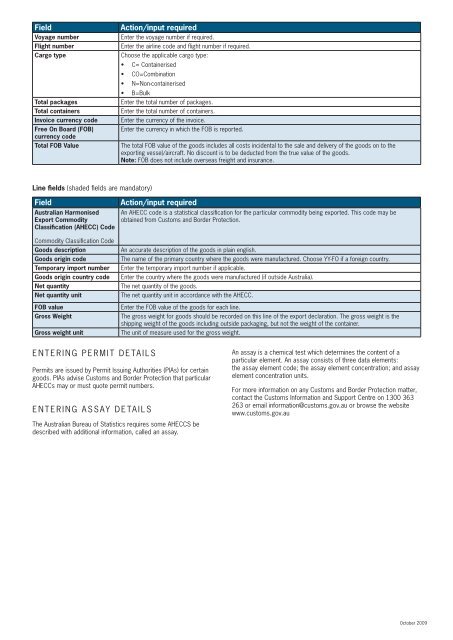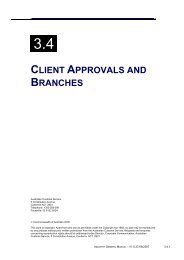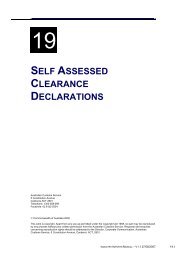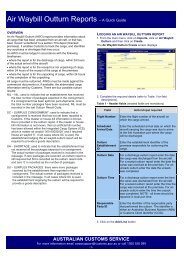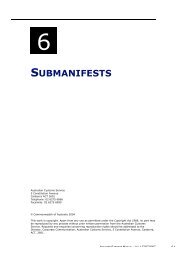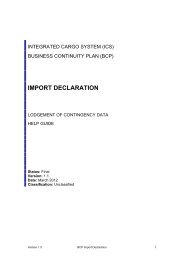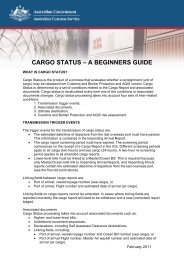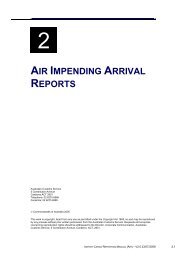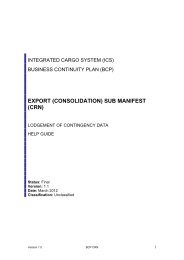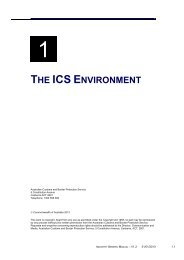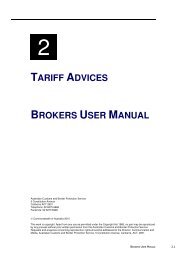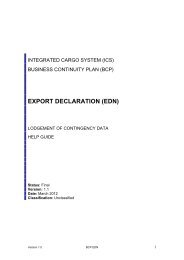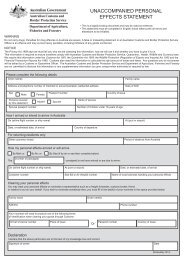Completing export deClarations - Australian Customs Service
Completing export deClarations - Australian Customs Service
Completing export deClarations - Australian Customs Service
Create successful ePaper yourself
Turn your PDF publications into a flip-book with our unique Google optimized e-Paper software.
Field<br />
Voyage number<br />
Flight number<br />
Cargo type<br />
Total packages<br />
Total containers<br />
Invoice currency code<br />
Free On Board (FOB)<br />
currency code<br />
Total FOB Value<br />
Action/input required<br />
Enter the voyage number if required.<br />
Enter the airline code and flight number if required.<br />
Choose the applicable cargo type:<br />
• C= Containerised<br />
• CO=Combination<br />
• N=Non-containerised<br />
• B=Bulk<br />
Enter the total number of packages.<br />
Enter the total number of containers.<br />
Enter the currency of the invoice.<br />
Enter the currency in which the FOB is reported.<br />
The total FOB value of the goods includes all costs incidental to the sale and delivery of the goods on to the<br />
<strong>export</strong>ing vessel/aircraft. No discount is to be deducted from the true value of the goods.<br />
Note: FOB does not include overseas freight and insurance.<br />
Line fields (shaded fields are mandatory)<br />
Field<br />
<strong>Australian</strong> Harmonised<br />
Export Commodity<br />
Classification (AHECC) Code<br />
Action/input required<br />
An AHECC code is a statistical classification for the particular commodity being <strong>export</strong>ed. This code may be<br />
obtained from <strong>Customs</strong> and Border Protection.<br />
Commodity Classification Code<br />
Goods description<br />
Goods origin code<br />
Temporary import number<br />
Goods origin country code<br />
Net quantity<br />
Net quantity unit<br />
FOB value<br />
Gross Weight<br />
Gross weight unit<br />
An accurate description of the goods in plain english.<br />
The name of the primary country where the goods were manufactured. Choose YY-FO if a foreign country.<br />
Enter the temporary import number if applicable.<br />
Enter the country where the goods were manufactured (if outside Australia).<br />
The net quantity of the goods.<br />
The net quantity unit in accordance with the AHECC.<br />
Enter the FOB value of the goods for each line.<br />
The gross weight for goods should be recorded on this line of the <strong>export</strong> declaration. The gross weight is the<br />
shipping weight of the goods including outside packaging, but not the weight of the container.<br />
The unit of measure used for the gross weight.<br />
Entering permit details<br />
Permits are issued by Permit Issuing Authorities (PIAs) for certain<br />
goods. PIAs advise <strong>Customs</strong> and Border Protection that particular<br />
AHECCs may or must quote permit numbers.<br />
Entering assay details<br />
An assay is a chemical test which determines the content of a<br />
particular element. An assay consists of three data elements:<br />
the assay element code; the assay element concentration; and assay<br />
element concentration units.<br />
For more information on any <strong>Customs</strong> and Border Protection matter,<br />
contact the <strong>Customs</strong> Information and Support Centre on 1300 363<br />
263 or email information@customs.gov.au or browse the website<br />
www.customs.gov.au<br />
The <strong>Australian</strong> Bureau of Statistics requires some AHECCS be<br />
described with additional information, called an assay.<br />
October 2009


